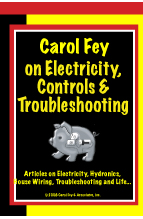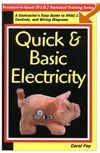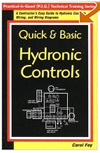by Carol Fey
Electronics let us do things that would otherwise be impossible.Joe
hates electronics. “Gol’dern new stuff. How can you fix it if
you can’t see how it works?”
Joe Jr., a generation younger, loves electronics. “Heck, Dad,
the self-diagnostics tell you what’s wrong, so there’s nothing
to figure out. But really, Dad, something else is usually the
problem, like the wiring. I’m just the kid around here, but
if you want to know how electronics work … ”
Frankly, Joe doesn’t want Joe Jr. to explain how electronics
work. He just wants the new stuff to go away. Then he can get
back to the days when he could spend an afternoon fiddling with
things until he got all the pieces apart and back together again.
It looks like Joe isn’t going to get his wish. Electronics are
here to stay, even in the not-always-so-progressive plumbing
and heating biz.
A few weeks ago, I attended a tankless water heater class. I
was astounded. Kyle, the manufacturer’s rep and trainer, said,
“If you’re here to learn how to install a water heater, you
might as well go home. This isn’t a water heater — it’s a computer.”
I looked around the room at 39 pairs of muddy plumber boots,
and thought, hmm, there’s going to be a stampede for the door.
But everyone stayed. Maybe the promise of food kept them in
their seats. Maybe they were just tired at the end of a long
day. Or perhaps the industry is changing.
Everything’s Changed
The world has changed. Cars are electronic. Appliances are electronic.
And yes, the plumbing and heating business is slowly becoming
electronic. Like with the tankless water heater, the manufacturers
aren’t giving us any choice. As rep Kyle said, “If your idea
of a water heater is still the old-fashioned ‘barrel on a campfire,’
this new stuff may not be for you.”
As I was listening to Kyle, I had a chance to think, “Well,
what are electronics, anyway? Just how are electronics so different
from ‘not-electronics?’”
The difference is what’s done with the electricity. With old-fashioned
electricity, you start with a particular voltage, say 24 volts,
and wave form, say alternating current (AC), and keep that.
All you do to control the circuit is turn the electricity on
or off with a switch.
In electronics, both can be changed. An amplifier circuit changes
voltage to adjust volume. In a variable-speed DC motor, the
waveform is changed.
But these differences aren’t what matters to us practical folks.
We want to know what it does. What’s it good for?
Electronics are useful because there are no moving parts to
maintain. There’s not much heat to dissipate. They don’t take
up much space. And even though electronic gizmos can be pricey,
compared to electro-mechanical alternatives, they are inexpensive
to manufacture.
Electronics let us do things that would otherwise be impossible.
The “computer” controls of the tankless water heater can bring
on just enough flame to add just enough Btus to keep the water
at set point. With a conventional water heater, we have one
size flame, and it can be either on or off. Temperature swing
(called differential) is probably an uncomfortable 15 degrees.
But let’s return to Joe’s predicament. He’s let electronics
remain a mystery even though they’ve been around most of his
life. It’s been half a century since words such as “solid state”
and “transistor” (remember transistor radios?) appeared. And
there are other words that we use all the time without thinking
about what they mean: LED, DIP switch, thermistor, semiconductor
and microprocessor.
Lingo
Let’s just go over what these words mean to show how un-mysterious
electronics is.
Solid state, as in solid-state circuit, simply means no moving
parts. It’s in a state of being solid.
A semiconductor is a material that conducts electricity under
certain conditions. Back in elementary science we learned that
metals conduct electricity and rubber and glass don’t. Semiconductors
are choosy about when and how they conduct.
Silicon is one of the materials that’s best for making semiconductors.
Thus Silicon Valley is the home of big semiconductor businesses.
When you look at an electronic “board,” or printed circuit board,
there are lots of bead-like pieces all over it. As a group there
are called semiconductors. Individually, they are resistors,
transistors, thermistors, diodes, SRCs, and triacs. Each has
a special function. On the board, they are wired together into
circuits, similar to a circuit that we’d make to wire a thermostat,
zone valve and transformer. Of course electronic circuits are
tiny. That’s how we get to words like “microelectronics” and
“microprocessor.”
Let’s take the mystery out of these little critters and look
at what they do:
An electronic resistor looks like a bead with colored rings
on it. Those colors are code for the amount of resistance each
has. Like in old-fashioned electricity, a resistor “resists”
the flow of electricity to cause desired things to happen.
A thermistor is a resistor whose resistance varies as the temperature
changes. It can communicate temperature by changing the resistance
it reports.
A transistor is a three-legged resistor that can use low voltage
to vary power into higher voltage circuits.
A diode looks like a resistor but has only one colored ring.
It allows electricity to flow only one direction.
A light-emitting diode (LED) creates light as the electricity
flows through it.
A DIP switch is often found in electronics from the 1980s and
1990s. DIP stands for “dual in-line package.” That means there’s
a line of tiny two-position switches. The switch positions you
select help tell the microprocessor what it’s supposed to do.
SRCs and triacs are electronic relays.
When the printed circuit board is connected to other devices,
it becomes a module or a microprocessor.
The devices that bring in information, or data, are called inputs.
In the heating business, typical inputs are temperature from
a thermistor and flame current from a flame sensor.
The module expects or “looks for” certain kinds of information
from the inputs. When it receives or “sees” the correct information,
it creates electrical output.
Output allows other devices to be turned on or off. Typical
output in the heating business would be to open a fuel valve
once the module has “proven” that there’s a need for heat and
that all of the safety conditions have been met.
The module turns input into output by using mathematical formulas
called algorithms. The result is called logic.
Because a module or microprocessor seems mysterious, it often
gets blamed when there’s a problem. Manufacturers say tens of
thousands are replaced needlessly every year.
The module is just the “thinker.” It’s completely dependent
upon having good input. That means that all the devices giving
it information need to be working correctly. It’s also dependent
upon the output devices being functional.
But the most frequent problem a module gets blamed for is in
the wiring bringing information into it or out from it. Do you
know the word intermittent? That usually means the wiring looks
solid, but somewhere a connection is loose.
No matter how simple we make the subject of electronics, Joe’s
still right. He darn well doesn’t have to learn anything “new,”
even though it’s been around more than 50 years. Joe thinks
that with all these changes, he just might hang up this business
after all these years. He thinks maybe he’ll just stay home
and watch his new giant flat screen TV. By golly, no one can
make him use electronics!Carol Fey
carol@carolfey.com
Carol Fey specializes in teaching electricity and controls to
plumbers and heating techs, young or old. Carol recently took
early retirement from Honeywell after 27 years. She's available
to do seminars on controls electricity and troubleshooting.
Contact her at 303/795-9350 or carol@carolfey.com. |




